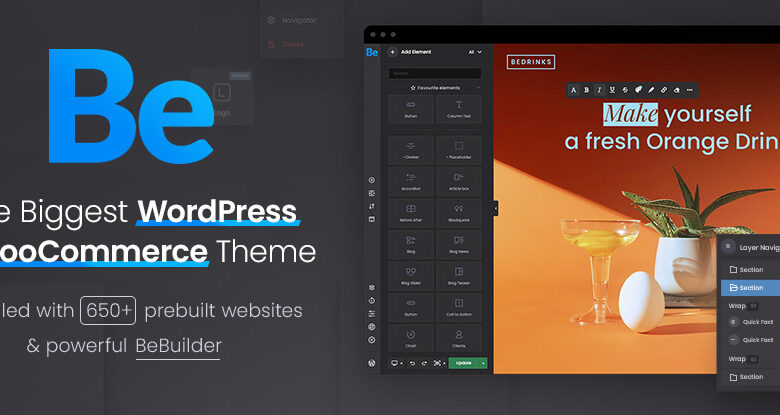More than a few web designers take up freelancing to fill in income gaps when business is slow, to add a little spice and variety to their work, or with the thought of working more for themselves and less for others. Even if you are fairly solidly situated in the business you are working for, you might find yourself in one or more of the above situations.
If you do freelancing on occasion, whether for enjoyment, or out of necessity, you’ve possibly given some thought to turning it into a full-time occupation. That’s a goal worth pursuing, but you first need to know a few things about how to establish and go about growing your new freelance business.
Following this piece of advice is all-important if you want to succeed. Simply working hard at your freelancing business won’t cut it. What you to do, is to work on your business.
This is how you go about it.
Be Parallax – Pre-built WordPress website
Full Time Freelancing Is a Business – Treat It that Way
You tend to develop a certain mindset about your freelance work if you are only doing it on a part-time or sporadic basis. Since you are a professional designer, you take the work you are doing seriously, whether it is for your employer or from your freelancing activities. That mindset, may be one of treating what you do for your client or employer as a business, but one of treating your freelancing activities as a diversion or a hobby. That needs to change, and doing so won’t always be easy.
You have to change your mindset about your freelancing and begin to treat it as a business. To do that, you have to learn how to run a business. It may take some time to do so, but the payoff can be great.
Where to start?
You’ll Need to Build a Great Portfolio
Be Portfolio – A Highly Popular Be Pre-Built Portfolio
Go over your past web design efforts and pick the ones you believe are your best. It takes a good portfolio to attract a potential client’s attention in this highly competitive industry. Comments, reviews, and testimonials about your work should be included. Showing both what you can do, and how you go about doing it, is important to these potential clients.
You want to include one or two examples that highlight your capabilities, and for a very good reason. You have to assume that most of those looking through your portfolio may only spend a minute or two in doing so. You have about that much time to convince someone searching for a professional web designer to decide you might be the answer.
You’re naturally super-critical of your own work. You need to take that attitude and apply it toward building your portfolio. Creating a near-perfect portfolio can be a challenge, but it’s doable; especially if you have the right tool for the job.
The right tool in this case is a pre-built website from Be Theme, a best-selling premium WordPress theme that has everything you need to put together an online portfolio that will make viewers sit up and take notice.
Brush Up on Your Marketing Tactics
As a professional web designer, you may feel that those in the marketing profession speak a foreign language. Now that you’ve decided to set up your own freelancing business, it’s time to start learning something about that language, and words like “client acquisition channels”, “A/B testing”, and “CRO funneling”. Understanding and researching these three terms will take you a long way.
- Client acquisition channels take many forms, ranging from social media to SEO marketing techniques, and even to how you name your website domain. One of the most effective acquisition channels is a blog. Blogging is a good way to tie into networks where you can showcase your work.
- Pay close attention to the homepage of your portfolio or portfolio website. You want it to clearly state your position or tell your story – like in this example.
- Have a plan in front of you that addresses the subjects or themes you want to write about. Pick one or more areas that you love working in, researching, or writing about. You only have to be a little more knowledgeable than the next guy to be considered an expert on a given subject, and people tend to gravitate toward experts.
- Measure the results of your acquisition channel activities. Keep a list of what you’ve done and what you’ve written and the response you’ve collected.
- Brush up on CRO funneling, how to approach it, and what it can do for you. Study the types of traffic you’re getting, good ways to collect leads, and how to interpret website testing results – like A/B testing.
You might even give some thought to publishing a weekly or monthly newsletter once your business is underway. As a final thought, it never hurts to ask someone who has been successful at the game for a few marketing tips or a little advice.
Growing Your Freelancing Business – A Summary
Freelancing can and should be fun, and if you treat it as a business, and not as a hobby, it can be highly profitable as well.
- You may not acquire the right mindset to run a business overnight, but you need to start working on it. The idea of working for yourself brings with it a certain amount of freedom, but it also requires taking on new responsibilities. As the CEO of your new venture, you get to call the shots, but you’ll also learn that decisions have consequences.
- Publish the best portfolio you are capable of doing. With the right tools at your disposal, putting together a truly awesome portfolio can be easier than you think. Be Theme, with its huge library of pre-designed websites, including several excellent portfolio-oriented selections, is just the right tool. Be Theme is easy to use, and it gives outstanding results.
- Don’t let being a techie get in the way of learning some of the ins and outs of marketing. Employing good marketing techniques is essential to your success. There’s a ton of free advice on the subject, but learning more about the marketing topics outlined above will take you a long way.
- Attend events, get on social media, and make networking a standard business practice. It not a matter of sell, sell, sell. It’s a matter of making yourself known and of building trust.










Leave a Reply